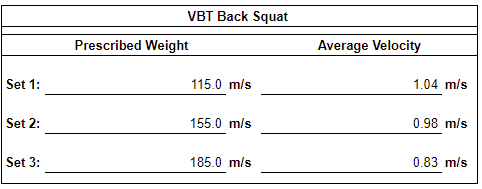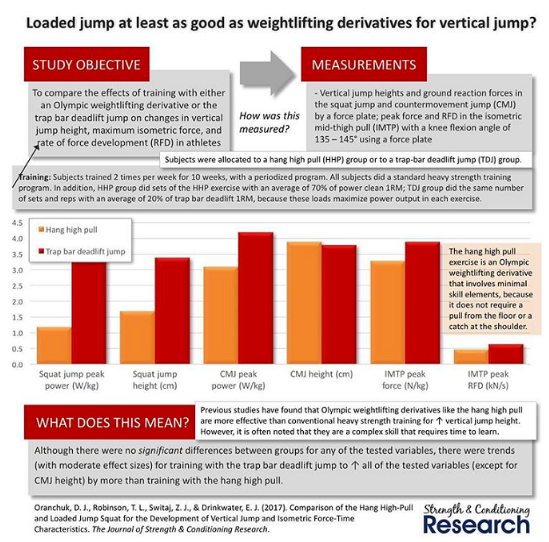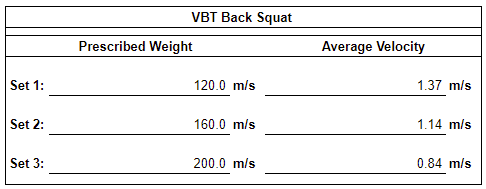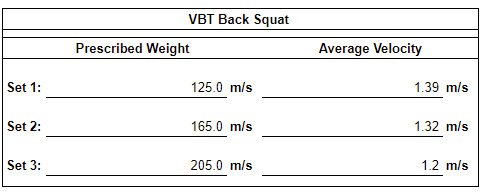Velocity-Based Training: Programming Considerations

We have written about what exactly velocity-based training is and how to broadly go about implementing that, but we wanted to go a bit more in-depth about the way many ways we use velocity-based training with our athletes at Driveline Baseball.
Assessment
During our strength assessment, we have athletes perform three sets of back squats, trap bar deadlifts, and barbell bench press. For each, we attach a Linear Displacement Transducer Device (currently a Tendo unit while we test our VBT unit) to the bar to determine the average bar velocities in meters per second. We use an algorithm to determine an estimated elite one-rep max based on their height and weight in order to determine how much weight each athlete will lift. The algorithm is roughly based on a two times body-weight squat, two and half times body-weight deadlift, and one and a half times body-weight bench press. We say roughly because a 225-pound athlete will have a much different perceived elite one-rep max than a 160-pound athlete, and a 6’ 6” inch athlete will have a much more difficult time squatting to depth than a 5’ 7” athlete. Once we determine that estimated one-rep max, we then test at 30%, 40%, and 50% of that number.
The velocities at these numbers give us a few different pieces of information that help us individualize our programs. First, there is a pass/fail aspect to the assessment. We want each rep to fall at or above certain velocity ranges. For example, the 30% rep should be >1.3 m/s, the 40% rep should be between 1.0 and 1.15m/s, and the 50% rep should be between 0.85 and 1.0 m/s.

Next, the spreads between the numbers will help us form a force-velocity profile for each athlete. For example, a strength-based athlete will perform the 50% rep better than the 30% rep, and a speed-based athlete may better perform the 30% or 40% rep than the 50% rep.

Percentage-based programming is the last piece of information we can use the velocities for. Because the weights that we test are relatively light and a much safer alternative to max testing, we can use the velocities to calculate a projected one-rep max. For example, 0.8 m/s is 60% of an athlete’s daily one-rep max—yes, a one-rep max can fluctuate based on the day. But, if an athlete moves 225 pounds at ~0.8 m/s, we can calculate that his projected one-rep max is 375 pounds on that given exercise. We can then take that information and prescribe sets of four reps at 70% of his one rep max if he is in a strength phase.
Programming for Strength and Power
While we primarily use velocity-based training for speed-based work, it can be a great tool when high bar velocities are not the training goal.
Earlier, we discussed how to use the assessment velocity numbers to prescribe weights for percentage-based programs, as well as how a projected one-rep max can fluctuate based on the day. One way to work around these factors and auto-regulate the on-the-bar load is to have feedback of bar velocity.
We know strength as 70-90%, for three to five sets of four to eight reps. If we compare this to the velocity-based training continuum, we see that falls in the accelerative strength velocity ranges of 0.5-0.75 m/s.
With that information, we could program three to five sets of four to eight reps and tell the athlete to find a weight that he can move all of the prescribed reps within that speed range. This will help autoregulate the load for him. On a day that the athlete is feeling more fatigued than usual, rather than forcing him to add 5-10 pounds to the bar and crushing them, we stay within the speed range and get the desired stimulus.
For power, we know that is three to five sets of two to five reps at 75-95% of a one-rep max. Because those percentages fall within both absolute strength and accelerative strength, I might have this athlete perform his prescribed sets and reps at a weight that he can move between 0.3 and 0.6 m/s.
Programming for High Velocity Ranges
The first speed range to touch on is strength/speed. Strength/speed is defined as moving a moderately heavy weight as fast as possible. The loads here range anywhere from 50 to 60% of a one-rep max and 0.75 and 1.0 m/s.
Speed/strength, on the other hand, is defined with speed as the first priority and strength as the second. In other words, it uses lighter loads at faster velocities. The loads here range from 30 to 40% of a one-rep max and velocities from 1.0 to 1.3 m/s.
An important note on training for speed/strength is that when performing the three main lifts of squat, deadlift, and bench press, the range of motion is too short to perform at velocities above 1.0 m/s. To make up for this, we recommend adding accommodating resistance in bands or chains to the bar. This allows the athlete to focus on accelerating the bar at high velocities without having to decelerate the bar as much at the top of the lift.
Starting strength is the last velocity range on the velocity-based training continuum. When training for starting strength, the load is 30% or less of a one-rep max, and it should be moved above 1.3 m/s. Starting strength is the ability to rapidly overcome inertia from a dead stop. The three main lifts should not be trained above 1.3 m/s. If you were to prescribe Olympic lifts, this would be the velocity range to train them in. At Driveline, we use Trap Bar Jumps at 1.3 m/s and above because research has shown that power output is similar and there is far less risk on athletes’ wrists and shoulders. They’re also easier to measure for power output due to a consistent bar path.

As far as sets and reps go for training in the speed ranges, we typically prescribe six sets of two reps. While the load is relatively light, the athlete should try to move the bar as fast as possible, which makes it a max-effort exercise. We know that when training for max power, the work rest ratio is 1:12, so an exercise lasting 5-10 seconds using the phosphagen energy system should have a rest period of 60 seconds.
Because of the shorter rest period, there is also a large work-capacity component to training in the speed-velocity ranges. This can result in athletes being better conditioned for the sport of baseball since actions occur roughly every 30 seconds in a baseball game.
How to Determine What Velocity Range to Prescribe
Earlier, we talked about how we can use velocities from the assessment to create a force velocity curve and figure out if an athlete is more strength-based or more speed-based. How an athlete profiles plays a huge role in how we program for them.

Here is an example of an athlete who profiles as more speed-based than strength-based. We can see that his 30% rep is at 1.37 m/s, which is above the 1.3 m/s number we are looking for, and his 50% rep is slightly below the 0.85-1.0 m/s range we are looking for. Some might see this and program maximum-strength work because it could be this athlete’s biggest room for adaptation. However, if we lose strength in the process of addressing a weakness, we are not improving this athlete. Because this athlete profiles as more speed-based, it may be disadvantageous for this athlete to spend too much time doing maximum-strength work and more beneficial for him to focus on improving his speed.

This example shows an athlete who is above what we are looking for on all three of his reps but likely profiles a bit more as strength-based by looking at how high his 50% rep is and the small spread between his 30% rep and 50% rep. Because he is well above on all three of his reps, he likely has reached a point of diminishing returns when it comes to maximum-strength work; taking his back squat from a projected one rep max of 405 to 500 is likely not the limiting factor in developing velocity.
With that being said, because this athlete is so strength-based, he may struggle when trying to perform speed work. An option for him would be to perform exercises in high velocity ranges with accommodating resistance in order to help him create the extra tension needed to move weight at high velocities.

In the final example, we can see that this athlete not only falls below the velocity ranges on all three reps, but also his spread is very short between all three reps. This tells us that the athlete lacks not only the ability to apply force but also to apply force quickly.
Because of that, we might do a more linear periodization with this athlete and spend some time doing strength work (0.5-0.75 m/s) until he lifts a certain number in that velocity range. Once the predetermined number has been hit, he can then move into an absolute strength block (0.3-0.6 m/s).
Once the athlete’s strength is sufficient, high velocity speed work can be prescribed.
Final Thoughts
Many people think of velocity-based training as a high velocity training protocol only, but
VBT is a great tool that can be used for assessment protocols, autoregulation during training blocks, and as a modality for elite athletes who have reached a point of diminishing returns with their maximum strength numbers. That point of diminishing returns will always be on a case-by-case basis, and that’s what makes test/retest periods so vital to writing a successful program.
This article was written by High Performance coach Kyle Rogers
Comment section
Add a Comment
You must be logged in to post a comment.
Roger W Robinson -
At what point does an athlete become able to produce enough force to be able to start to train speed strength? Is it relative to body weight?
Driveline Baseball -
Roger- You can use 2.5X bodyweight(BW) in the deadlift, 2X BW squat, and 1.5X BW bench for ideal 1 rep max numbers (keep in mind the height of the athlete). Using sub-maximal weight to determine force production – the 30% rep should be >1.3 m/s, the 40% rep should be between 1.0 and 1.15m/s, and the 50% rep should be between 0.85 and 1.0 m/s. If those are met, the athlete will be put into a strength program prioritizing speed.
Brett -
Is velocity based training okay to do in season? Or is it only for the offseason?
Driveline Baseball -
Hey Brett, VBT can be used in season. Most of the time we will be dialing back the volume of the workouts for in season work. The main goal for most of our higher level athletes is maintenance. We want to maintain strength while still putting them in the best position, physically, to compete in games.